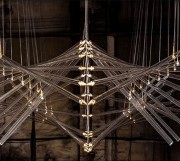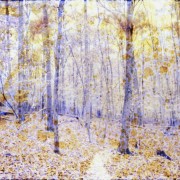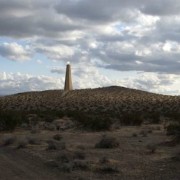Visual Arts
In a startling variety of ways, contemporary artists are exploring the relationship that our species has to its planet. We have aggregated some of this very intriguing work below. If you have suggestions for works to add to the gallery, please contact us.
Works can also be viewed in portfolio view.
2014-15 Curator: Julia Olson

Amsterdam-based design studio Studio Drift created In 20 Steps. With 40 glass tubes, the sculpture appears as an abstract flapping of wings, like an enormous bird of glass elegantly taking flight within the space. Last month, the installation debuted at the Venice Biennale as part of the Glasstress 2015 Gotika, a combined exposition from the Hermitage in Sint Petersburg and the Berengo Studio in Venice.
In a press release, Studio Drift-founders, Ralph Nauta and Lonneke Gordjin write, “Studio Drift is intrigued by the continuous attempts of humankind to deal with its limitations, so miraculously opposed to nature as these ventures might be. Humankind has always had the desire to fully understand nature and to detach itself from earthly ties. No matter how far science has come, some things are likely to remain forever out of reach.” (source).
[easy-share buttons=”facebook,twitter,linkedin,mail” counters=0 native=”no” image=https://live-ehc-english-ucsb-edu-v01.pantheonsite.io/wp-content/uploads/2014/11/yusuke-asai-waf-1.jpg url=https://live-ehc-english-ucsb-edu-v01.pantheonsite.io/?p=9348 facebook_text=Share twitter_text=Tweet linkedin_text=Link text=”In 20 Steps”]

We’re familiar with composting food, but composting photographs? For a new photo series, Ajay Malghan set out to see what dirt, water, and other forces of nature would do to his pictures. It turns out the process can leave behind ghostly patterns and texture (when it doesn’t completely destroy the photograph). “Any wrong move (hand bumping the tray, syringe slips etc.) ruins the image…Most of images don’t work out.” Sometimes “not working out” means the photo disintegrates, but other times the result is a psychedelic mass of color. Malghan collected his successful photos into a series called Collaborations with Nature, some of which can look charming and vintage, or turn the freeze-framed woodlands and waterfalls into something terrifying. (source).
[easy-share buttons=”facebook,twitter,linkedin,mail” counters=0 native=”no” image=https://live-ehc-english-ucsb-edu-v01.pantheonsite.io/wp-content/uploads/2014/11/yusuke-asai-waf-1.jpg url=https://live-ehc-english-ucsb-edu-v01.pantheonsite.io/?p=8142 facebook_text=Share twitter_text=Tweet linkedin_text=Link text=”Composting Pictures”]


At first, the thought of a lighthouse in the desert seems like a ridiculous idea, but if you’ve ever driven across the vast expanse of a desert yourself (especially at night), you might know how unsettling it is to not have even a tiny glowing beacon to help guide you. In this sense, a lighthouse would serve the same function as it does by the lake, sea, or ocean. It was this realization that first compelled multimedia artist Daniel Hawkins to embark on the ambitious endeavor of building his own lighthouse in California’s Mojave Desert.
“This time around I am sparing no expenses. The lighthouse will be fully fortified,” Hawkins resolves. “It always was and is grounded in my belief in the need for this stabilizing beacon of light. It seems so essential in an era of destroyed landmarks, radical environmental change, economic turmoil, private space travel, and increasingly surreal local war games.” (source).
[easy-share buttons=”facebook,twitter,linkedin,mail” counters=0 native=”no” image=https://live-ehc-english-ucsb-edu-v01.pantheonsite.io/wp-content/uploads/2014/11/yusuke-asai-waf-1.jpg url=https://live-ehc-english-ucsb-edu-v01.pantheonsite.io/?p=8102 facebook_text=Share twitter_text=Tweet linkedin_text=Link text=”Desert Lighthouse”]





Mineral crystals grown on thin threads form the shape of a chair in this installation by Japanese designer Tokujin Yoshioka. He created the Spider’s Thread sculpture of a chair by suspending just seven filaments within a frame that was set in a pool of mineral solution. The solution was drawn up the threads and gradually formed into crystals around them, fleshing out into the shape of a piece of furniture. “Spider’s Thread applies the structure of natural crystals in an advanced way aiming to produce a form even closer to the natural form,” said Yoshioka. The designer says this iteration references a traditional story by Japanese writer Ryunosuke Akutagawa. “The Buddha takes a thread of a spider in Heaven and lowers it down to Hell so that the criminal can climb up from Hell to Paradise,” explains Yoshioka. “In the story, the thread of a spider is a symbol of slight hope and fragility.” (source).
[easy-share buttons=”facebook,twitter,linkedin,mail” counters=0 native=”no” image=https://live-ehc-english-ucsb-edu-v01.pantheonsite.io/wp-content/uploads/2015/12/Yoshiokas-Spiders-Thread-1.jpg url=https://live-ehc-english-ucsb-edu-v01.pantheonsite.io/?p=11986 facebook_text=Share twitter_text=Tweet linkedin_text=Link text=”Spider’s Thread”]
If you notice a massive, polygonal being sunning itself by the sea, you may have just stumbled upon DIVA, an 11.5-foot-tall paper sculpture hand-built by French artist Thomas Voillaume, a.k.a APACH. DIVA is made up of 853 triangles, constructed over four weeks of repetitive tracing, cutting, and assembly which APACH says put him in a trance-like state, opening, “les portes d’une autre dimension”— the door to another dimension — as the sculpture took shape. The giant humanoid looks like it could have wandered ashore from some other reality, while its two-part structure creates the illusion of it phasing right through the ground. (source).
[easy-share buttons=”facebook,twitter,linkedin,mail” counters=0 native=”no” image=https://live-ehc-english-ucsb-edu-v01.pantheonsite.io/wp-content/uploads/2014/11/yusuke-asai-waf-1.jpg url=https://live-ehc-english-ucsb-edu-v01.pantheonsite.io/?p=9374 facebook_text=Share twitter_text=Tweet linkedin_text=Link text=”DIVA”]